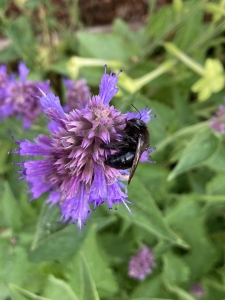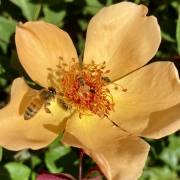Enjoy pollinators in your garden, Avoid Neonics
Neonics is a common pesticide that is harmful to bees, butterflies, and other pollinators.
So, what are neonicotinoids?
Neonicotinoids (neonics for short) are one of the most commonly used pesticides for gardens. They are effective against harmful pests, easily applied and relatively safe for humans. However, what you may not know is that they are highly toxic to beneficial non‑targeted organisms such as pollinators, beneficial insects, birds, and other important organisms. No pesticide is risk free, even eco-friendly pesticides. However, neonics pose a greater risk because of their persistence and staying power within the environment.
Neonics are systemic pesticides, moving though all the plant’s tissue, accumulating in the leaves, the flower pollen and flower nectar. Neonics can be applied as soil drenches, foliar sprays, and tree injections. The most common for the home gardener are the soil drench products with the active ingredient of imidacloprid. These pesticides persist in the plant for months, and even years once applied. They are commonly used on lawns to combat grubs and other lawn pests, on ornamental flowering plants, like roses & perennials to eliminate aphids and other flower pests, and for trees, including fruit trees. These neonics not only kill the intended problem pest but are also directly linked to pollinator mortality.

Bees are extremely sensitive to these pesticides. The pesticide remains present in the pollen and nectar of the flowers. Foraging bees are exposed, which impairs their ability to navigate and damages their immune systems. Bees in the hive that consume collected pollen containing neonics have reduced reproduction rates, and population decline. For butterflies, the risks are similar. It is documented that Monarch larvae died within 7 days after feeding on leaves of milkweed that had been treated with the neonic imidacloprid per the label’s application instructions. For birds, they are exposed to this lethal pesticide when they consume the seeds from treated plants and when hummingbirds drink the nectar. Ladybugs and other beneficial insects are also killed by the exposure to neonics.
Neonics are designed to be a durable and long-lasting pesticide. They are water soluble which allows them to move through the soil during a rain event, making it possible to be absorbed beyond the area where they were applied, exposing wildflowers and other plants. Neonics make their way into the ground water and waterways.
Continued applications of neonics create a toxic environment to all insects, good or bad, directly weakening the ecosystem in your garden.
A less toxic approach to pest management – Alternatives to Neonics
Proper pest identification is key. If we can’t identify the pest then we won’t be able to correct the pest problem. Once we identify the pest, we want to understand it’s life cycle, perhaps we don’t have to take any action if the pest’s lifecycle is completed. Get curious to see if there are any beneficial predators around that may be taking care of the pest for us. If we need to use a pesticide, then chose the least toxic possible.
For example, lawn grubs are combated by applying beneficial nematodes to the turf. Beneficial nematodes are non-toxic microscopic worm like organisms that feed on soil dwelling organisms. You can purchase beneficial nematodes at your local independent garden center. Aphids are easily removed by wiping them off by hand or syringing them off with a spray bottle of water. Insecticidal Soap is the best choice if you are looking for an eco-friendly pesticide.
For more information on specific pests, less-toxic pest management, and how pesticides work, visit:
- rrwatershed.org/project/our-water-our-world
- Our Water Our World: ourwaterourworld.com
- UC IPM websites: ucanr.edu
- National Pesticide Information Center: orst.edu
- Bio-Integral Research Center: https://www.birc.org/
This article was authored by Suzanne Bontempo, of Plant Harmony and program manager of Our Water Our World, on behalf of RRWA. RRWA (www.rrwatershed.org) is an association of local public agencies in the Russian River Watershed that have come together to coordinate regional programs for clean water, habitat restoration, and watershed enhancement.




